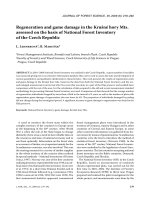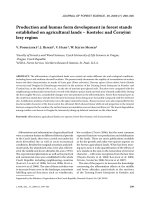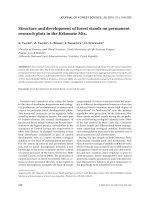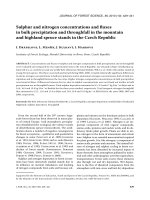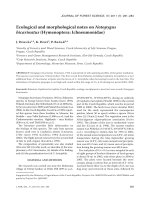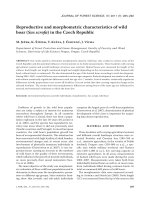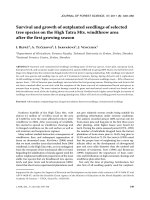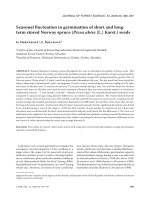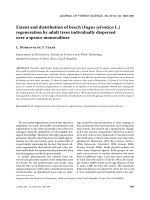Báo cáo lâm nghiệp: "Intra- and interannual variations of transpiration, leaf area index and radial growth of a sessile oak stand (Quercus petraea)" doc
Bạn đang xem bản rút gọn của tài liệu. Xem và tải ngay bản đầy đủ của tài liệu tại đây (958.45 KB, 16 trang )
Original
article
Intra-
and
interannual
variations
of
transpiration,
leaf
area
index
and
radial
growth
of
a
sessile
oak
stand
(Quercus
petraea)
N
Bréda,
A
Granier
Équipe
bioclimatologie
et
écophysiologie
forestière,
Unité
d’écophysiologie
forestière,
Centre
de
Nancy,
Inra,
54280
Champenoux,
France
(Received
15
December
1994;
accepted
19
June
1995)
Summary —
Bud-burst,
leaf
area
index
(LAI),
transpiration,
soil
water
content
and
radial
growth
of
a
35-year-old
Quercus
petraea
stand
were
measured
during
5
successive
years
(1989-1993).
At
the
begin-
ning
of
1992,
half
of
the
stand
was
thinned.
The
increase
of
stand
transpiration
during
spring
was
lin-
early
correlated
to
the
development
of
LAI.
During
the
second
part
of
the
season,
although
LAI
continued
to
increase
because
of
rhythmic
shoot
development,
transpiration
was
strongly
reduced
as
soil
water
content
decreased.
The
transpiration/potential
evapotranspiration
(T/PET)
ratio
decreased
sharply
as
soon
as
relative
extractable
water
(REW)
dropped
below
0.4.
Likewise,
cumulated
stand
transpiration
varied
among
years
because
of
variability
in
soil
water
availability,
LAI
and
canopy
structure.
A
linear
relationship,
similar
to
the
one
observed
for
weekly
variations,
was
noted
between
T/PET
and
LAI;
max-
imum
LAI
ranged
from
3.3
to
6
in
this
ring-porous
species.
Seasonal
circumference
measurements
showed
that
43%
of
the
annual
increment
was
achieved
before
leaf
development,
hence
before
canopy
transpiration
and
CO
2
assimilation
were
started.
Tree
ring
area
was
significantly
correlated
to
the
cumulated
transpiration;
a
water-use
efficiency
variable
was
defined
at
both
tree
and
stand
level.
transpiration
/
leaf
area
index
/
drought
/
circumference
increment
/
Quercus
petraea
Résumé —
Variations
intra-
et
interannuelles
de
transpiration,
d’indice
foliaire
et
de
croissance
radiale
d’un
peuplement
de
chêne
sessile
(Quercus
petraea).
Le
débourrement,
l’indice
foliaire
(LAI),
la
transpiration,
la
teneur
en
eau
du
sol
et
la
croissance
en
circonférence
d’un
peuplement
de
Quer-
cus
petraea
âgé
de
35
ans
ont
été
mesurés
pendant
5
années
successives
(1989
à
1993,
fig
6).
Au
début
de
l’année
1992,
la
moitié
du peuplement
a été
éclaircie.
L’augmentation
de
la
transpiration
du peu-
plement
au
printemps
était
linéairement
corrélée
à
LAI
(fig
2).
Au
cours
de
la
seconde
partie
de
la
saison,
même
si
LAI
continuait
à
augmenter
en
raison
de
la
croissance
rythmique
des
pousses,
la
trans-
piration
était
fortement
réduite
par
la
sécheresse
édaphique.
Le
rapport
transpiration/ETP
diminuait
rapi-
dement
dès
que
la
fraction
disponible
de
l’eau
du
sol
chutait
en
dessous
de
0,4
(fig
3).
De
même,
la
tran-
spiration
cumulée
du
peuplement
variait
entre
les
années
avec
la
disponibilité
en
eau
du
sol,
le
LAI
et
la
structure
du
couvert.
Une
relation
linéaire
similaire
à
celle
observée
à
l’échelle
hebdomadaire
a
été
mise
en
évidence
entre
T/ETP
et
LAI
pour
une
gamme
de
LAI
s’étendant
de
3,3
à
6,0,
selon
les
années
et
la
densité
des
traitements
(fig
8).
Les
mesures
d’accroissement
en
circonférence
au
cours
de
la
saison
ont
montré
que
43
%
de
l’accroissement
annuel
était
réalisé
avant
le
développement
des
feuilles
(fig
4),
donc
avant
la
reprise
de
transpiration
et
d’assimilation
du
carbone.
La
surface
de
chaque
cerne
était
significativement
corrélée
à
la
transpiration
cumulée
au
cours
de
la
saison
de
végétation
(fig
10).
Une
variable
d’efficience
d’utilisation
de
l’eau
a
été
définie
à
la
fois
à
l’échelle
de
l’arbre
et
du
peuplement.
transpiration
/ indice
foliaire
/ sécheresse
/ croissance
en
circonférence
/ Quercus
petraea
INTRODUCTION
Fundamental
requirements
in
modelling
for-
est
ecosystem
processes
are
the
rates
and
control
of
energy,
carbon,
water
and
nutrient
exchange
by
forested
surfaces,
and
the
responses
of
these
surfaces
to
natural
or
silvicultural
perturbations
such
as
canopy
opening,
or
to
precipitation
deficits
or
excess.
Moreover,
production
depends
on
leaf
area
and
may
be
influenced
by
canopy
structural
characteristics
(canopy
stratifica-
tion
and
coverage,
leaf
area
index)
(Roberts
et
al,
1993)
as
well
as
ambient
weather
con-
ditions
(Jarvis
and
McNaughton,
1986;
Run-
ning,
1986).
Therefore,
an
analysis
of
the
growth
and
health
of
forest
stands
needs
a
good
description
of
crown
condition
and
an
accurate
estimate
of
drought-induced
stress
on
both
a
daily
and
annual
basis.
Leaf
area
index
(LAI,
the
ratio
of
leaf
area
per
unit
ground
area)
was
often
found
to
be
a
powerful
parameter
for
the
analysis
of
stand
structure.
A
high
LAI
is
an
indication
of
high
site
fertility
and
optimal
stand
health
and
productivity.
In
many
models,
it
is
the
main
independent
variable
for
determining
canopy
interception,
transpiration,
respira-
tion,
photosynthesis,
carbon
allocation
and
litterfall
(Running
and
Coughlan,
1988).
LAI
varies
from
stand
to
stand.
Among
variables
regulating
leaf
area,
soil
water
availability,
as
determined
by
climate
and
soil
properties,
is
by
far
the
most
significant.
The
effect
of
water
deficit
on
leaf
growth
may
even
be
more
important
to
stand
productivity
than
its
effect
on
photosynthesis
(Gholz
et
al,
1990).
Leaf
area,
climate
and
soil
should
then
interact
and
one
may
assume
that
an
ecological
equilibrium
links
these
parame-
ters.
This
assumption
has
been
directly
ver-
ified
at
regional
scale
and
for
coniferous
stands
(Grier and
Running,
1977).
In
another
way,
transpiration
integrates
soil
water
availability
and
the
atmospheric
evaporative
demand,
and
has
a
great
influ-
ence
on
physiological
processes
that
deter-
mine
carbon
fixation
and
growth
(Nemani
and
Running,
1989).
As
shown
by
simulta-
neous
measurements
of
water
vapour
and
carbon
dioxide
fluxes
from
a
deciduous
for-
est
by
eddy
correlation
method,
canopy
pho-
tosynthesis
and
transpiration
are
strongly
and
linearly
correlated
(Baldocchi
et
al,
1987).
There
is
much
evidence
that
biomass
production
is
correlated
with
water
use
(Legg
et
al,
1979;
Schulze
and
Hall,
1981;
Bal-
docchi
et
al,
1987;
Honeysett
et
al,
1992).
However,
these
observations
were
mainly
reported
at
the
stand
level
and
on
an
annual
basis.
Little
information
concerning
the
mag-
nitude
and
the
timing
of
intraannual
varia-
tions
of
transpiration,
LAI,
drought
and
growth
exists.
Many
agricultural
studies
have
shown
that
transpiration
approaches
a
max-
imum
at
a
LAI
less
than
3,
the
point
of
canopy
closure
(Brun
et
al,
1972;
Saugier
and
Katerji,
1991).
Almost
no
data
are
avail-
able
for
trees,
and
one
may
assume
that
the
high
canopy
stratification
may
lead
to
different
canopy
behaviour
for
forest
stands.
The
aim
of
this
study
was
to
analyse
the
relationships
between
transpiration
and
growth
in
an
oak
stand,
on
both
seasonal
and
annual
time
paces.
The
modifications
of
transpiration
were
successively
analysed
as
a
consequence
of
i)
seasonal
and
annual
variations
in
leaf
area
index
and
ii)
soil
water
balance.
Finally,
tree
and
stand
growth
were
described
in
relation
to
water
use.
SITE
AND
MEASUREMENTS
The
study
was
conducted
during
5
years
from
1989
in
an
almost
pure
Quercus
petraea
stand
in
Champenoux
Forest,
France
(48°44N,
6°14E,
altitude
237
m).
The
stand
was
naturally
regenerated,
fol-
lowing
the
1961s
acorn
production.
At
the
beginning
of
1992,
half
of
the
stand
(0.16
ha)
was
thinned.
Thirty-five
percent
of
the
basal
area
(28%
of
the
sapwood
area)
was
removed,
leaving
a
plot
with
a
basal
area
of
17.6
m2
·ha
-1
and
tree
density
of
3
077
trees·ha
-1
.
The
unthinned
part
(control)
had
24.6
m2
·ha
-1
and
3
352
trees·ha
-1
(for
fur-
ther
details,
see
Bréda
et
al,
1993a
and
1995).
Radial
increment
Seasonal
circumference
increment
at
breast
height
was
measured
manually
every
10
days
on
a
sample
of
100
to
175
trees
in
each
treatment,
from
mid-March
to
October
during
the
whole
experiment.
The
reference
level
was
marked
with
a
circle
painted
after
smoothing
the
bark.
Readings
were
made
on
dry
stems
to
avoid
bark
swelling.
Data
were
expressed
as
the
mean
cumulated
increment
for
four
initial
circumference
classes
(<
200,
200-300,
300-400
mm
and
>
400
mm)
or
as
relative
circumference
growth
(Hunt,
1982).
These
classes
corre-
sponded
approximately
to
trees
in
sup-
pressed,
intermediate,
codominant
and
dominant
crown
position
in
the
canopy,
respectively.
The
size
of
each
class
was
related
to
diameter
distribution
in
the
stand.
In
addition
to
this
extensive
growth
record,
25
trees
were
randomly
selected
in
the
con-
trol
stand
to
analyse
radial
increment
from
tree
rings,
since
the
origin
of
the
stand.
Two
cores
per
tree
were
extracted
at
1.3
m
above
ground
along
the
north-south
direction.
Mea-
surements
from
the
two
cores
were
aver-
aged.
Ring
width
was
measured
using
a
semi-automatic
device
(Becker,
1989),
and
cross-dated.
As
the
boundary
between
ear-
lywood
and
latewood
was
easily
detected
(differing
by
the
size
of
xylem
elements),
both
were
separately
measured.
Annual
width
and
basal
area
were
computed
for
each
year
ring.
Leaf area index
The
intraannual
variation
in
LAI
was
moni-
tored
from
both
global
radiation
interception
(thermopyranometers,
INRA,
France)
and
LAI-meter
(Demon,
CSIRO,
Australia),
according
to
the
procedure
described
by
Bréda
et
al
(1995).
Litter
collection
during
autumn
provided
every
year
a
direct
esti-
mate
of
maximal
LAI.
The
leaf-fall
collection
was
based
on
49
trays
(0.25
m2)
from
1989
to
1991,
and
21
traps
in
each
plot
after
thin-
ning.
LAI
was
calculated
from
daily
global
radiation
interception
by
inverting
the
Beer-Lambert
equation.
Light
extinction
coefficients,
as
determined
from
allometric
estimates
of
maximal
LAI
(sapwood-leaf
area
relationship)
were
0.38
and
0.28
in
con-
trol
and
thinned
stands,
respectively.
Bud-burst
observations
Bud-burst
observations
were
recorded
from
mid-April
to
end
of
May
on a
sample
of
ten
control
and
15
thinned
trees
from
each
plot
on
a
2-day
time
notation.
Bud
development
was
described
according
to
a
six
stage
scale
(dormant
winter
buds,
swollen
buds,
bro-
ken
buds,
just-unfolded
leaves,
unfolded
leaves,
developed
leaves
with
elongation
of
twigs).
Bud-burst
index
ranged
from
0
to
100
and
was
computed
as
the
mean
nota-
tion
of
the
ten
or
15
trees.
Shoot
flushing
events
were
also
dated,
but
no
quantitative
estimate
was
performed.
Stand
transpiration
Stand
transpiration
was
estimated
from
sap
flow
measurements
monitored
on
a
sample
of
four
to
eight
trees
(table
I).
A
larger
num-
ber
of
trees
was
measured
in
the
thinned
plot
where
the
variability
was
higher
(Bréda
et
al,
1995).
Trees
were
chosen
according
to
the
sapwood
distribution
in
the
stand.
The
radial
sap
flowmeters
(Granier,
1987)
were
inserted
every
year
before
bud-break
and
removed
during
October.
Sap
flow
data
were
collected
on a
half
hour
basis.
These
devices
measure
sap
flow
per
unit
of
sap-
wood
area
(sap
flux
density).
Since
both
control
and
thinned
trees
exhibited
the
same
linear
sapwood-leaf
area
relationship
(Bréda
et
al,
1995),
sap
flow
density
was
propor-
tional
to
vapour
flux
density
per
unit
leaf
area
(ie,
transpiration)
with
the
same
ratio.
Sap
flow
cumulated
over
the
growing
sea-
son
(l.year
-1
)
was
calculated
for
each
tree
as
the
product
of
sap
flux
density
by
the
sapwood
area
at
the
sensor
level.
Stand
transpiration
(T,
mm.day
-1
)
was
finally
com-
puted
from
individual
sap
flow
density
mea-
surements
and
stand
sapwood
area
per
unit
of
ground
area.
At
the
end
of
the
experiment,
two
cores
were
extracted
from
all
the
trees
used
for
sap
flow
(18
trees)
to
measure
precisely
radial
increment
during
the
5
studied
years
as
previously
described.
Soil
water
content
Soil
water
content
was
monitored
during
the
5
years
of
survey
using
a
neutron
probe
(Nordisk
Elektrisk
Apparatfabrik,
Denmark).
Measurements
were
performed
every
week
during
the
growing
season,
and
monthly
during
the
winter.
The
actual
soil
water
con-
tent
(R)
was
computed
from
soil
moisture
profiles
(0-160
cm)
resulting
from
counts
logged
every
10
cm
(from
surface
to
1
m
deep)
or
20
cm
(below
1
m).
The
access
tubes
network
used
in
each
treatment
and
year
is
presented
in
table
I.
Soil
water
avail-
ability
in
the
rooted
zone
was
expressed
as
relative
extractable
water
calculated
as
REW=
(R -
R
min
)
/
(R
max
-
R
min
),
where
R
is
the
actual
soil
water
content
(mean
value
computed
from
n
access
tubes),
R
min
the
minimum
soil
water
content
observed
in
experimental
dry
plots,
R
max
the
soil
water
content
at
field
capacity.
Total
soil
extractable
water
(R
max
-
R
min
)
was
165
mm.
Climate
data
Climate
data
were
monitored
2
m
above
the
canopy
and
logged
every
30
min
with
a
Campbell
(CR7)
from
May
to
October.
The
weather
station
included
a
pyranometer
(Kipp
&
Zonen
[Delf,
Holland]
or
Cimel
[Paris,
France]),
a
ventilated
psychrometer
with
platinum
sensors
(model INRA)
and
an
anemometer
(Vector
Instruments
[Rhyl,
UK]).
Evapotranspiration
was
computed
according
to
the
Penman
equation.
RESULTS
Seasonal
fluctuations
of
leaf
area
index,
transpiration
and
growth
Transpiration
increased
in
the
spring
as
soon
as
leaf
expansion
began
(fig
1).
The
dynamics
of
foliage
development
were
so
rapid
that
day-to-day
increases
in
leaf
area
were
detected
by
changes
in
transmitted
global
radiation.
On
10
May
(day
130),
the
time-course
of
sap
flow
and
hence
of
tran-
spiration
was
only
20%
of
potential
evapo-
transpiration
(PET).
Transpiration
reached
50%
of
PET
after
8
days,
while
the
first
flush
was
expanded
and
80%
of
the
maximal
LAI
was
completed.
It
should
be
noted
that
sap
flow
first
lagged
behind
PET
during
the
morning
of
the
first
days
at
the
beginning
of
May.
This time
lag
disappeared
after
1
week
and
may
have
involved
stored
stem
water.
This
increase
in
stand
transpiration
dur-
ing
the
spring
was
linearly
correlated
with
LAI
until
complete
expansion
of
the
first
flush
(fig
2).
The
scatter
around
this
regression
was
related
to
differences
in
soil
water
avail-
ability
and/or
in
PET
conditions
among
weeks.
Nevertheless,
some
differences
among
years
were
detected,
the
main
one
being
observed
in
1990
with
higher
tran-
spiration
rates
than
the
following
year.
In
1989
and
1991,
sap
flow
measurements
started
too
late
to
monitor
the
spring
increase
of
transpiration.
An
increase
of
T/PET
in
the
thinned
as
compared
to
control
was
observed
in
1993,
while
a
single
regres-
sion
had
been
observed
for
both
treatments
in
1992.
Leaf
area
index
reached
at
least
80%
of
maximum
before
soil
moisture
deficits
began.
As
a
consequence,
drought
effects
could
be
analysed
without
large
fluctuation
of
LAI.
The
effect
of
soil
water
depletion
on
transpiration
during
the
summer
is
shown
in
figure
3.
The
ratio
of
transpiration
over
PET
was
affected
when
soil
water
content
dropped
below
40%
of
REW.
This
threshold
for
regulation
of
transpiration
was
also
detected
from
reductions
in
canopy
con-
ductance
(see
Granier and
Bréda,
1996).
The
carbon
allocation
patterns
during
the
growing
season
have
been
indirectly
assessed
from
phenological
and
growth
observations.
Seasonal
measurements
of
circumference
showed
that
about
43%
(on
average
over
the
5
years)
of
the
annual
increment
was
achieved
before
any
signifi-
cant
leaf
development
(figure
4),
hence
before
transpiration
and
CO
2
assimilation
had
started.
In
particular,
the
whole
anatom-
ical
earlywood
(wood
zone
including
large
vessels),
representing
19%
of
the
annual
tree
ring,
was
completely
established
by
the
end
of
April,
that
is,
1
month
before
leaf
emergence
(end
of
May).
It
may
be
con-
cluded
that
earlywood
was
formed
from
car-
bon
resources
accumulated
during
the
pre-
vious
years.
At
the
end
of
spring
(21
June),
and
hence
before
summer
drought,
the
main
part
of
cumulated
circumference
increment
was
achieved.
A
larger
sample
of
ring
widths
of
sessile
oaks
from
this
stand
demonstrated
that
the
annual
increment
of
earlywood
was
independent
of
soil
water
deficit
(fig
5).
Soil
water
deficit
was
computed
from
a
daily
water
balance
model,
using
climatic
data
to
drive
transpiration,
interception
and
evap-
oration
(Bréda,
1994).
In
contrast,
a
signif-
icant,
negative
effect
of
soil
water
deficit
was
observed
on
latewood
thickness.
Spring
frost
during
the
previous
year
contributed
to
residual
variation.
Year-to-year
variations
in
transpiration
and
leaf
area
index
Figure
6
compares
the
annual
time-courses
of
T/PET,
LAI,
circumference
increment
and
relative
extractable
water
observed
during
the
5
years
of
survey.
It
shows
that
maxi-
mal
transpiration,
maximal
LAI
and
minimal
soil
water
content
varied
from
year
to
year.
These
annual
characteristics
are
also
reported
in
table
II.
Leaf
area
index
increased
from
spring
to
autumn
in
relation
to
the
rhythmic
shoot
growth
of
the
oaks
(three
flushes
were
usually
observed).
The
increase
of
LAI
resulting
from
the
second
and
third
flushes
was
not
always
followed
by
an
increase
of
transpiration,
because
i)
juvenile
leaves
exhibited
low
stomatal
con-
ductance
and
ii)
they
appeared
during
peri-
ods
of
high
PET-
inducing
stomatal
closure.
The
different
transpiration
rates
among
years
were
accompanied
by
different
cir-
cumference
increments.
The
annual
cir-
increment
curves
exhibited
the
same
pattern
during
the
5
years:
a
linear
part
which
stopped
every
year
around
15
July,
followed
by
a
plateau.
The
date
of
this
cessation
of
growth
was
independent
of
soil
water
content
and
may
reflect
a
pattern
of
growth
mainly
determined
by
day-length
and
cumulated
temperatures.
Some
fluctu-
ations
during
the
second
part
of
the
growing
season
depended
on
relative
extractable
water
and
may
have
reflected
changes
in
stem
water
content
rather
than
growth
events.
In
particular,
stem
shrinkage
appeared
when
REW
dropped
below
the
threshold
of
0.4.
The
final
annual
increment
was
therefore
mostly
dependent
on
the
rate
of
circumference
increment
during
the
spring,
calculated
from
the
linear
part
of
the
seasonal
curve
of
growth
(fig
7).
No
differ-
ence
between
control
and
thinned
stands
appeared
and
a
single
regression
was
cal-
culated
without
1991
data
(r
2
=
0.89).
Data
from
1991
were
excluded
because
the
initial
rate
of
increment
was
significantly
lower
in
that
year,
perhaps
because
of
a
severe
spring
frost
(-4.2
°C
on
24
April).
In
1990,
both
high
water
supply
and
LAI
led
to
the
highest
growth.
The
last
2
years
(1992-1993)
exhibited
summer
droughts
and
also
a
lower
LAI.
On
a
seasonal
basis,
a
linear
relation-
ship
appeared
between
annual
mean
T/PET
and
LAI
(fig
8).
During
the
study,
maximum
LAI
ranged
between
3.3
and
6,
depending
on
the
year
and
the
stand
density.
In
the
control
plot,
LAI
and
T/PET
decreased
in
proportion
from
1989
to
1993.
In
the
thinned
plot,
T/PET
increased
between
1992
and
1993
without
any
modification
of
LAI
as
a
consequence
of
i)
a greater
light
use
effi-
ciency
bacause
of
better
crown
exposure
and
ii)
a
higher
soil
water
availability
(Bréda
et al,
1995).
Annual
growth
and
water
use
The
similarity
between
interannual
varia-
tions
in
annual
circumference
increment
and
transpiration
at
the
stand
level
is
shown
in
figure
9a,
b.
Because
leaf
area
index
var-
ied
among
years
and
treatments,
the
use
of
the
transpiration/LAI
ratio
permits
a
direct
comparison.
Year-to-year
changes
in
T/LAI
and
growth
varied
similarly.
The
amount
of
water
needed
to
achieve
a
given
basal
incre-
ment
is
the
slope
of
the
linear
regression
between
T/LAI
and
relative
growth
(r
2
=
0.74)
(fig
9c).
It
represents
a
stand
index
of
water-use
efficiency
for
growth
integrated
over
the
growing
season.
This
index
appeared
constant
among
years,
and
it
may
be
concluded
that
no
change
in
carbon
allo-
cation
between
stem
and
other
compart-
ments
could
be
detected.
The
previously
mentioned
increase
of
transpiration
in
1993
in
the
thinned
(figs
8
and
9a)
stand
was
not
accompanied
by
an
improved
growth
(fig
9b).
An
improvement
of
growth
was
observed
during
the
following
year
(1994).
The
thinned
stand
exhibited
a
too
high
tran-
spiration
rate
as
compared
to
its
growth
as
exemplified
by
its
deviation
from
the
regres-
sion
between
T/LAI
and
relative
growth
(fig
9c).
This
deviation
from
the
line
may
have
reflected
changes
in
carbon
allocation
pat-
terns
within
the
thinned
trees
(crown
growth,
root
system
development,
stemwood
res-
piration).
In
the
same
way,
sap
flow
measurements
allow
us
to
analyse
the
relationship
between
growth
and
transpiration
at
the
tree
scale.
Yearly
basal
area
increment
is
also
well
cor-
related
with
the
amount
of
transpiration
over
the
growing
season
(ring
area
=
0.339
*
Σ
SF,
n
=
28,
r2
=
0.65;
fig
10),
and
it
might
be
proportional
to
the
amount
of
fixed
CO
2.
The
slope
of
this
regression
may
be
defined
as
an
index
of
efficiency
for
circumference
growth
at
the
tree
scale.
It
exhibited
only
slight
(nonsignificant)
variations
among
years.
Nevertheless,
some
of
the
thinned
trees
exhibited
a
lower
slope
during
1993,
as
mentioned
for
the
stand
level.
DISCUSSION
Long-term
monitoring
of
sap
flow
and
cli-
matic
data
(from
bud-burst
to
leaf
fall)
were
suitable
to
analyse
the
dependence
of
tran-
spiration
on
both
LAI
and
PET.
The
sap
flowmeter
device
allowed
us
to
detect
small
daily
fluctuations
of
transpiration
occurring
during
leaf flushing
(fig
1),
owing
to
its
fine
time
resolution.
Prediction
of
transpiration
as
a
function
of
LAI
has
been
developed
since
several
years
in
order
to
estimate
crop
water
use
and
to
quantify
the
amount
of
water
needed
for
irrigation
(Brun
et
al,
1972).
As
a
general
conclusion
with
crop
and
grassland,
a
curvilinear
relationship
was
observed
between
T/PET
and
LAI
on
well-
watered
soils.
An
almost
linear
increase
was
observed
until
a
LAI
of
about
2.5
(Ritchie
and
Burnett,
1971).
Afterwards,
T/PET
increased
more
gradually
until
it
approached
an
asymptote.
Further
uncreases
in
LAI
did
not
result
in
additional
interception
of
total
radiation
(Saugier and
Katerji,
1991).
An
increase
of
transpiration
area
would
induce
locally
a
lower
water
vapour
pressure
deficit.
In
addition,
local
exchange
will
be
reduced
because
of
wind
sheltering
and
the
poor
coupling
between
crop
canopy
transpira-
tion
and
the
atmosphere
(Jarvis
and
McNaughton,
1986);
therefore,
transpira-
tion
versus
LAI
would
increase
less
than
linearly.
Such
results
are
scarce
for
mature
and
deciduous
forests,
because
reliable
LAI
monitoring
during
leaf
flushing
has
been
only
recently
developed.
The
linear
increase
of
T/PET
with
leaf
area
until
a
LAI
of
6.0
was
reached
(fig
2)
is
somewhat
surprising
as
compared
to
crop
canopy
behaviour.
The
absence
of
a
threshold
LAI leading
to
satu-
ration of
T
may
reflect
specific
properties
of
the
oak
canopy:
i)
The
canopy
transpiration
is
strongly
coupled
with
the
atmosphere
(see
Granier
and
Bréda,
1996)
so
that
the
previ-
ously
mentioned
sheltering
effect
is
small
(Bosveld
et
al,
1991).
ii)
The
spatial
arrange-
ment
of
leaves
and,
in
particuliar,
the
clump-
ing
(associated
with
flushing
and
a
short
vertical
extension
of
the
crowns)
lead
to
a
highly
porous
canopy.
This
was
also
illus-
trated
by
the
low
light
extinction
coefficient
determined
for
this
canopy
as
compared
to
a
grassland
(0.38
and
0.70,
respectively).
As
a
consequence,
T
was
proportional
to
the
amount
of
foliage
until
a
LAI
of
6.0
because
radiation
was
still
available
at
the
base
of
the
crown.
As
another
consequence
of
this
canopy
porosity,
slight
vertical
gra-
dients
of
vapour
pressure
deficit
were
mea-
sured
inside
the
crown
and
only
small
dif-
ferences
in
stomatal
conductance
were
observed
between
the
top
and
base
of
the
crown
(Bréda
et
al,
1995).
Seasonal
fluctuations
in
transpiration
(T/PET)
have
been
related
to
LAI
and
soil
water
availability.
Leaf
area
index
appeared
as
the
main
parameter
governing
the
T/PET
ratio
during
the
first
part
of
the
season,
when
soil
water
content
was
not
limiting
(0.4
<
REW
<
1).
For
our
site,
we
never
observed
spring
drought
and
bud-burst
always
occurred
as
soil
water
content
was
near
field
capacity.
The
studied
trees
were
about
35
years
old
and
the
rhythmic
shoot
elon-
gation
was
still
important,
in
comparison
to
the
general
assessment
that
such
a
crown
development
typically
concerns
resprouts
and
young
saplings
(Longman
and
Coutts,
1974).
Therefore,
increases
in
LAI
beyond
6.0
had
only
a
limited
impact
on
T/PET
because
during
this
second
part
of
the
grow-
ing
period,
T/PET
was
reduced
by
stomatal
closure
resulting
from
soil
water
deficits
(Bréda,
1993a).
A
sharp
decrease
in
T/PET
was
observed
as
REW
dropped
below
0.4,
a
threshold
caused
by
the
depletion
of
water
from
the
soil
macroporosity
(Bréda
et
al,
1994).
For
oaks,
midday
stomatal
conduc-
tance
was
then
reduced
by
half.
During
the
5
years
of
measurements,
the
stand
experienced
various
climatic
and
soil
moisture
conditions
that
yielded
an
excel-
lent
opportunity
to
study
the
interactions
between
LAI,
drought
and
transpiration
on
the
same
site.
Such
a
single
site,
multi-year
approach
is
interesting
because
most
exper-
imental
data
is
derived
from
multi-site
com-
parisons
of
water
consumption
along
soil
moisture
gradients
(Gholz,
1982).
As
a
result
of
this
latter
approach,
a
direct
proportionality
between
LAI
and
transpiration
is
assumed,
but
without
experimental
support
(Nemani
and
Running,
1989).
It
is
sometimes
assumed
that
mature
forest
stands
with
closed
canopies
support
constant
amounts
(weight
or
area)
of
foliage
(Jack
and
Long,
1991).
Gholz
and
Fischer
(1982)
showed
that
the
amount
of
foliage
may
slowly
decline
over
time.
Such
a
reduction
in
LAI
follow-
ing
canopy
closure
is
often
associated
with
a
reduction
in
leaf
area
efficiency
(reduc-
tion of
both
the
amount
of
leaf
area
and
leaf
area
efficiency;
Long
and
Smith,
1992).
In
contrast,
our
results
demonstrated
that
a
close
canopy
represents
an
instable
steady
state
where
biotic
or
climatic
factor
may
lead
to
imbalance.
In
our
stand,
LAI
varied
substantially
from
one
year
to
the
next;
however,
a
decreasing
trend
has
been
observed
since
1991.
This
decrease
in
LAI
(without
tree
mortality)
was
a
general
feature
in
oak
stands
in
northeast
France
during
this
period:
the
foliage
loss
index
observed
in
the
European
Network
of
forest
vitality
survey
(Ministère
de
l’Agricul-
ture
et
de
la
Forêt,
1994)
followed
the
same
pattern
as
our
stand
(fig
11).
The
good
agreement
between
measurements
of
LAI
variations
and
annual
assessment
of
defo-
liation
(as
a
percentage
of
leaf
loss)
has
to
be
mentioned,
because
it
stresses
the
sig-
nificance
of
’defoliation
estimates’
gener-
ally
used
for
health
surveys.
We
did
not
observe
any
variation
in
individual
leaf
size
among
years
(data
not
shown)
and
the
reduction
of
LAI
was
thus
a
consequence
of
the
reduction
in
the
number
of
leaves.
The
1991
spring
frost
occurred
when
leaves
were
just
unfolded,
and
-4.2
°C
tempera-
ture
corresponds
to
the
critical
temperature
leading
to
frost
injuries
for
sessile
oak
(Liepe,
1993).
This
frost
probably
had
major
con-
sequences
on
water
transport
and
hence
on
tree
vitality;
all
large
vessels
of
the
newly
formed
earlywood
were
likely
cavitated
at
least
in
the
terminal
shoots
(Sperry
and
Sul-
livan,
1993).
The
hydraulic
conductance
may
then
be
reduced
by
the
late
freeze,
both
during
that
spring
and
that
summer,
as
reported
by
Sperry
et
al
(1994).
Indeed,
these
authors
observed
that
no
additional
layer
of
earlywood
vessels
was
produced
following
the
freeze
and
that
the
latewood
produced
had
an
insignificant
effect
on
hydraulic
conductance.
The
primary
carbo-
hydrate
and
nutrient
sources
for
the
initial
and
then
for
the
replacement
leaf
flushing
were
stored
reserves.
Because
the
previ-
ous
year
had
been
wet,
one
might
expect
an
optimum
carbon
accumulation.
The
lack
of
reduction
of
maximal
LAI
in
1991
was
somewhat
surprising,
as
it
was
also
an
exceptionally
dry
year.
An
important
con-
sideration
regarding
this
result
is
the
inter-
action
between
the
two
climatic
constraints
(spring
frost
and
drought).
As
buds
were
completely
destroyed,
the
leaf
expansion
was
delayed
by
3
weeks,
so
that
water
uptake
was
also
delayed.
This
saving
of
water
allowed
an
important
but
somewhat
erratic
development
of
lamna
shoots,
which
normally
would
have
been
reduced
by
the
drought.
The
assimilated
CO
2
was
then
allo-
cated
to
shoots
and
leaf
production
rather
than
stored.
As
a
consequence,
LAI
of
the
following
year
(1992)
was
reduced.
Similar
persistent
effects
of
the
1991
spring
frost
on
1992
and
1993
oak
crown
conditions
in
Rheinland
were
reported
(Schröck
and
Block,
personal
communication).
Year-to-year
variations
in
growth
were
high,
as
observed
for
LAI.
It
was
suspected
that
low
leaf
area
may
become
the
limiting
factor
for
carbon
gain
and
growth.
As
a
con-
sequence
of
substantial
variations
of
LAI
from
one
year
to
the
next
due
to
either
nat-
ural
factors
or
thinning,
maximal
T/PET
under
optimum
water
supply
(REW
>
0.4)
may
have
varied
from
0.5
to
0.8
in
proportion
to
LAI.
The
amount
of
foliage
is
then
the
most
important
origin
of
annual
transpired
water
and
hence
of
canopy
photosynthesis
(Baldocchi
et
al,
1987),
because
it
deter-
mines
the
transpiration
rate
during
the
period
of
high
water
consumption.
Besides,
as
the
annual
T/PET
was
closely
correlated
to
LAI
(r
2
=
0.82),
residual
variation
being
corre-
lated
to
soil
moisture
deficit.
Annual
basal
increment
was
strongly
related
to
transpi-
ration,
which
depends
on
both
LAI
and
soil
water
availability
during
the
summer.
In
fact,
growth
rate
is
proportional
to
the
amount
of
radiation
intercepted
by
the
canopy.
As
inter-
cepted
light
is
mainly
determined
by
the
amount
of
foliage,
LAI
expresses
the
growth
potential
of
the
stand
(Jarvis
and
Leverenz,
1983).
Inversely,
LAI
seemed
to
depend
on
growth
from
the
previous
year,
thus
giving
LAI
an
intermediate
position
between
two
successive
annual
growths.
The
current
growth
rate
(slope
of
the
growth
curve)
may
be
influenced
by
the
previous
year’s
soil
water
availability
(which
determines
the
amount
of
carbohydrates
stored)
and
the
current
year’s
spring
frost.
A
direct
effect
of
spring
frosts
on
circumference
growth
has
been
cited
for
broad-leaf
species
(oak,
hick-
ory,
beech;
Liu
and
Muller,
1993;
Santini
et
al,
1994).
The
study
of
tree
growth by
anal-
ysis
of
annual
growth
rings
allowed
us
to
consider
a
longer
temporal
period
and
has
revealed
the
differential
effect
of
soil
mois-
ture
deficit
on
early-
and
latewood
incre-
ment.
The
earlywood
was
independent
of
soil
moisture
deficit
but
its
development
(April)
was
strongly
influenced
by
temper-
ature,
as
observed
by
Hinckley
et
al
(1976)
or
Becker
et
al
(1994).
In
contrast,
the
late-
wood
growth
appeared
related
to
soil
water
deficit
Hinckley
et
al
(1976)
called
this
phase
of
stem
growth
"the
oil
moisture
limited
phase".
This
result
is
also
consistent
with
the
climatic
model
of
interannual
variation
in
growth
developed
by
Becker
et
al
(1994):
stemwood
growth
appeared
to
be
related
to
fluctuations
in
precipitation
in
May,
June
and
August.
The
monitoring
of
both
cumulated
cir-
cumference
growth
and
water
transport
dur-
ing
several
complete
growing
seasons
has
provided
new
information
about
the
func-
tional
interaction
between
foliar
phenology
and
tree
water
relations.
A
large
part
(43%
on
average
in
the
5
years)
of
the
annual
diameter
increment
takes
place
during
the
spring
before
leaf
expansion;
this
propor-
tion
includes
more
than
the
earlywood
(=
only
19%
of
ring
width).
Hinckley
and
Las-
soie
(1981)
also
mentioned
that
approxi-
mately
30%
of
the
total
stem
increment
is
added
before
bud-burst
in
ring-porous
hard-
wood.
Our
observation
is
also
consistent
with
Dougherty
et
al’s
(1979)
early
mea-
surements
of
photosynthesis
on
white
oak.
They
showed
that
most
of
the
early
growth
processes
were
either
completed
or
well
underway
before
the
establishment
of
sig-
nificant
rates
of
net
photosynthesis.
They
observed
that
when
leaves
were
rapidly
expanding,
stem
(but
also
root)
cambial
growth
virtually
ceased;
this
transition
phase
may
correspond
to
the
beginning
of
late-
wood
production.
Leave
expansion
acts
as
a
sink
of
stored
photosynthetates.
Spring
cambial
growth
is
therefore
independent
of
the
re-activation
of
buds
and
is
not
affected
by
current
drought.
As
large
vessels
of
oaks
exhibited
high
vulnerability
to
frost-induced
embolism
(Cochard
et
al,
1992;
Bréda
et
al,
1993b),
and
as
only
rings
of
the
more
recent
years
are
functional
(Granier
et
al,
1994),
a
new
layer
of
xylem
must
be
developed
to
ensure
water
supply
of
young
leaves
(Essiamah
and
Eschrich,
1986;
Sperry
et
al,
1994).
Stored
carbohydrates
from
the
previous
year
are
then
involved
during
spring
in
both
xylem
differentiation
and
leaf
expansion.
This
phenological
cycle
in
which
cambium
re-activation
precedes
leaf
devel-
opment
usually
characterises
ring-porous
species
(Hinckley
and
Lassoie,
1981;
Wang
et
al,
1992)
and
has
been
observed
on
Cas-
tanea
sativa
(Boutin,
1985)
and
on
Sorbus
torminalis
(Lachaud
and
Mansouri,
1993).
Lachaud
and
Bonnemain
(1981)
observed
in
30-year-old
oaks
that
cambial
re-activation
occurred
at
least
3
weeks
before
bud-burst.
We
also
observed
that
this
time
lag
between
cambial
growth
and
leaf
expansion
leads
to
an
exceptionally
high
hydraulic
conductance
from
soil-to-leaves
during
spring,
which
was
strongly
reduced
after
a
few
weeks
as
leaves
expanded
(Bréda
et
al,
1993a).
In
contrast,
cambium
re-activation
and
bud-
burst
occur
simultaneously
as
observed
in
Fagus
by
Lachaud
and
Bonnemain
(1981)
or
growth
follows
bud-burst
in
diffuse
porous
species
in
which
vessels
function
for
sev-
eral
years
(Gasson,
1987;
Anfodillo
et
al,
1993).
We
computed
an
index
of
water-use
effi-
ciency
integrated
over
the
season
at
both
stand
and
tree
level,
and
it
was
expressed
as
the
ratio
of
annual
basal
increment
over
cumulated
sap
flow.
This
index
is
only
an
indicator
because
i)
we
used
basal
area
instead
of
volume
production,
ii)
respiration
was
not
taken
into
account
and
iii)
no
attempt
was
made
to
partition
biomass
to
components
other
than
the
stem.
The
lat-
ter
point
has
certainly
to
be
involved
to
explain
the
apparent
lower
water-use
effi-
ciency
of
trees
from
the
thinned
plot,
where
crown
development
was
higher
than
in
con-
trol
trees.
Nevertheless,
the
water-use
effi-
ciency
for
growth,
as
defined,
was
constant
among
years,
probably
because
the
stand
balances
(via
control
of
transpiration,
adjust-
ment
of
LAI)
to
maintain
this
constant
effi-
ciency.
This
balance
may
be
a
characteris-
tic
of
the
species
at
this
stage
of
development
and
on
this
site.
Unfortunately,
our
direct
measurements
of
carbon
assim-
ilation
were
not
suitable
to
investigate
the
intrayear
variation
in
intrinsic
water-use
effi-
ciency
(assimilation
versus
transpiration
at
leaf
scale).
Measuring
carbon
isotope
com-
position
in
the
annual
growth
rings
will
allow
assessing
indirectly
a
time-integrated
value
of
water-use
efficiency.
CONCLUSION
The
data
collected
during
the
5
years
of
sur-
vey
at
Champenoux,
France
exhibit
large
year-to-year
variations
in
LAI
and
soil
mois-
ture,
which
gave
an
accurate
parametriza-
tion
of
both
seasonal
and
interannual
trends
of
T/PET.
The
mechanism
involved
in
the
interactions
between
intensity
and
duration
of
drought,
LAI,
transpiration
and
basal
area
increment
have
been
presented.
Our
results
provided
strong
evidence
that
taking
into
account
year-to-year
fluctuations
in
LAI
will
improve
water
balance
and
growth
mod-
elling.
Nevertheless,
the
understanding
of
interannual
variations
of
LAI
needs
further
research,
including
the
collection
of
longer
temporal
series
of
LAI
to
quantify
delayed
effects
of
this
parameter
on
long-term
trends
in
growth.
ACKNOWLEDGMENTS
This
work
has
been
conducted
during
a
PhD
sup-
ported
by
a
national
grant
from
the
Research
and
Education
Department.
The
framework
for
this
project
has
been
provided
by
the
National
For-
est
Office
(ONF)
and
funded
by
GIP
"Écosys-
tèmes
forestiers"
and
EC
research
program
STEP
"Water
stress,
system
dysfunctions
and
mecha-
nisms
of
dieback
in
European
oaks"
STEP CT
90
0050.
B
Clerc
and
F
Willm
are
gratefully
acknowledged
for
their
field
assistance
in
mea-
surements
and
in
the
survey
of
experimental
design.
The
authors
thank
P
Behr
and
JL
Dupouey
for
tree
ring
analysis
and
E
Dreyer
for
helpful
discussions
and
for
coordinating
the
STEP
project.
REFERENCES
Anfodillo
T,
Sigalotti
GB,
Tomasi
M,
Semenzato
P,
Valen-
tini
R
(1993)
Applications
of
a
thermal
imaging
tech-
nique
in
the
study
of
the
ascent
of
sap
in
woody
species.
Plant
Cell
Environ
16,
997-1001
Baldocchi
DD,
Verma
SB,
Anderson
DE
(1987)
Canopy
photosynthesis
and
water
use
efficiency
in
a
decid-
uous
forest.
J Appl Ecol 24,
251-260
Becker
M
(1989)
The
role of
climate
on
present
and
past
vitality
of
silver
fir
forests
in
the
Vosges
mountains
of
northeastern
France.
Can
J
For
Res
19,
1110-1117
Becker
M,
Nieminen
TM,
Gérémia
F
(1994)
Short-term
variations
and
long-term
changes
in
oak
productiv-
ity
in
northeastern
France.
The
role
of
climate
and
atmospheric
CO
2.
Ann
Sci
For 51,
477-492
Bosveld
FC,
Bouten
F,
Noppert
F,
Steingrover
E
(1991)
A
transpiration
model
for
a
Douglas
fir
forest.
A
deter-
mininistic
approach.
In:
CORRELACI
(PW
Evers,
ed),
Dorschkamp
Publication,
The
Dorschkamp,
Wageningen,
the
Netherlands,
163-186
Boutin
B
(1985)
Etude
de
la
reactivation
cambiale
chez
un
arbre
ayant
un
bois
à
zones
poreuses
(Castanea
sativa)
et
deux
autres
au
bois
à pores
diffus
(Betula
verrucosa,
Acer
campestre).
Can
J Bot
63,
1335-
1343
Breda N (1994)
Analyse
du
fonctionnement
hydrique
des
chênes
sessiles
(Quercus
petraea)
et
pédon-
culé
(Q
robur)
en
conditions
naturelles;
effets
des
facteurs
du
milieu
et
de
l’éclaircie.
PhD
Thesis,
Uni-
versity
of
Nancy-I,
France,
56
p
Breda
N, Cochard
H, Dreyer
E,
Granier
A
(1993a)
Water
transfer
in
a
mature
oak
stand
(Ouercus petraea):
seasonal
evolution
and
effects
of
a
severe
drought.
Can
J
For
Res
23, 1136-1143
Breda
N,
Granier
A,
Dreyer
E,
Cochard
H
(1993b)
Effects
of
soil
water
depletion
on
water
relation
of
Quercus
petraea
and
Quercus
robur under
natural
conditions
at
Champenoux
forest
(France).
Ann
Sci
For
50,
571-582.
Breda
N,
Granier
A,
Aussenac
G
(1995)
Effects
of
thin-
ning
on
soil
water
balance
and
tree
water
relations,
transpiration
and
growth
in
an
oak
forest
(Quercus
petraea).
Tree
Physiol 15,
295-306
Brun
LJ,
Kanemasu
ET,
Powers
WL
(1972)
Evapotran-
spiration
from
soybean
and
sorghum
fields.
Agron
J
64, 145-148
Cochard
H,
Breda
N,
Granier
A,
Aussenac
G
(1992)
Vulnerability
to
air
embolism
of
three
European
oak
species
(Quercus
petraea
(Matt)
Liebl,
Q
pubescens
Willd,
Q
roburL).
Ann
Sci
For 49,
225-233
Dougherty
PM,
Teskey
RO,
Phelps
JE,
Hinckley
TM
(1979)
Net
photosynthesis
and
early
growth
trends
of a dominant
white
oak
(Quercus
alba
L).
Plant
Physiol 64, 930-935
Essiamah
S,
Eschrich
W
(1986)
Water
uptake
in
decid-
uous
trees
during
winter
and
the
role
of
conducting
tissue
in
spring
reactivation.
IAWA
Bull 7,
31-38
Gasson
P
(1987)
Some
implications
of
anatomical
vari-
ations
in
the
wood
of
pedunculate
Oak
(Quercus
robur L)
including
comparison
with
common
Beech
(Fagus
sylvatica
L).
IAWA
Bull 8, 149-166
Gholz
HL
(1982)
Environmental
limits
on
above-ground
net
primary
production, leaf
area, and
biomass
in
vegetation
zones
of
the
Pacific
Northwest.
Ecology
63, 469-481
Gholz
HL,
Fischer
RF
(1982)
Organic
matter
produc-
tion
and
distribution
in
slash
pine
(Pinus
elliottii)
plan-
tations
Ecology 63,
1827-1839
Gholz
HL,
Ewel
KC,
Teskey
RO
(1990)
Water
and
forest
productivity.
For
Ecol
Manage
30,
1-18
Granier
A,
(1987)
Evaluation
of
transpiration
in
a
Douglas
fir
stand
by
means
of
sap
flow
measurements.
Tree
Physiol 3,
309-320
Granier
A,
Anfodillo
T,
Sabatti
M,
Cochard
H,
Dreyer
E,
Tomasi
M,
Valentini
R,
Breda
N
(1994)
Axial
water
flow
in
the
trunk
of
oak
trees:
a
quantitative
and
qual-
itative
analysis.
Tree Physiol 14,
1383-1396
Granier
A,
Bréda
N
(1995)
Modelling
canopy
conduc-
tance
and
stand
transpiration
of
an
oak
forest
from
sap
flow
measurements.
Ann
Sci For 53,
537-546
Grier
CC,
Running
SW
(1977)
Leaf
area
of
mature
north-
western
coniferous
forests:
relation
to
site
water
bal-
ance.
Ecology 58,
893-899
Hinckley TM,
Lassoie
JP
(1981)
Radial
growth
in
conifers
and
deciduous
trees:
a
comparison.
Mitt
Forstlichen
Bundesversuchsanstalt
(Vienna)
142,
17-56
Hinckley TM,
Thompson
DR,
McGinness
NP,
Hinckley
AR
(1976)
Stem
Growth and
Phenology
of
a
Domi-
nant
White
Oak.
Central
Hardwood
Forest
Confer-
ence.
Proceedings
of
First
Meeting
at
Southern
Illi-
nois
University
at
Carbonale
(JS
Fralish,
GT
Warner,
RC
Schlesinger,
eds),
Missouri
Agricultural
Experi-
ment
Station,
Journal
Series
7564,
187-201
Honeysett JL,
Beadle
CL,
Turnbull
CRA
(1992)
Evapo-
transpiration
and
growth
of
two
contrasting
species
of
Eucalyptus
under
non-limiting
and
limiting
water
availability.
For
Ecol Manage
50, 203-216
Hunt
R
(1982)
Plant
Growth
Curves.
The
Functional
Approach
to
Plant
Growth
Analysis.
Edward
Arnold,
London,
UK,
248
p
Jack
SB,
Long
JN
(1991)
Analysis
of
stand
density
effects
on
canopy
structure:
a
conceptual
approach.
Trees
5,
44-49
Jarvis
PG,
Leverenz JW
(1983)
Productivity
of
temper-
ate,
deciduous
and
evergreen
forests.
In:
Encyclo-
pedia
of Plant
Physiology
(OL
Lange,
PS
Nobel,
CB
Osmond,
H
Ziegler,
eds),
new
series,
vol
12D,
Springer-Verlag,
Berlin,
234-280
Jarvis
PG,
McNaughton
KG
(1986)
Stomatal
control
of
transpiration:
scaling
up
from
leaf
to
region.
Adv
Ecol
Res
15, 1-49
Lachaud
S,
Bonnemain
JL
(1981)
Xylogenèse
chez
les
Dicotylédones
arborescentes.
I.
Modalités
de
la
remise
en
activité
du
cambium
et
de
la
xylogénèse
chez
les
Hêtres
et
les
Chênes
âgés.
Can
J
Bot 59,
1222-1230
Lachaud
S,
Mansouri
A
(1993)
Reprise
de
l’activité
du
cambium
et
xylogenèse
chez
l’Alisier
Torminal.
Rev
For
Fr
3,
279-283
Legg
BJ,
Day
W,
Lawlor
DW,
Parkinson
KJ
(1979)
The
effects
of
drought
on
barley
growth:
models and
measurements
showing
the
relative
importance
of
leaf
area
and
photosynthetic
rate.
J
Agric
Sci
92,
706-716
Liepe
K
(1993)
Growth-chamber
trial
on
frost
hardiness
and
field
trial
on
flushing
of
sessile
oak
(Quercus
petraea
Liebl).
Ann
Sci For 50,
208s-214s
Liu
Y,
Muller
RN
(1993)
Effect
of
drought
and
frost
on
radial
growth
of
overstory
and
understory
stems
in
a
deciduous
forest.
Am
Midl
Nat
129,
19-25
Long
JN,
Smith
FW
(1992)
Volume
increment
in
Pinus
contorta
var
latifolia:
the
influence
of
stand
devel-
opment
and
crown
dynamics.
For
Ecol
Manage
53,
53-64
Longman
KA,
Coutts
MP
(1974)
Physiology
of
the
oak
tree.
In:
The
British
Oak:
Its
History,
and
Natural
His-
tory.
Morris,
Perring,
The
Botanical
Society
of
the
British
Isles,
EW
Classey
ltd,
UK,
194-221
Ministère
de
l’Agriculture
et
de
la
Forêt
(1994)
La
Santé
des
Forêts
(France)
en
1993.
DERF,
Département
de
la
Santé
des
Forêts,
Paris,
France,
120
p
Nemani
RR,
Running
SW
(1989)
Testing
a
theoretical
cli-
mate-soil-leaf
area
hydrologic
equilibrium
of
forests
using
satellite
data
and
ecosystem
simulation.
Agric
For Meteorol 44,
245-260
Ritchie
JT,
Burnett
E
(1971)
Dryland
evaporative
flux
in
subhumid
climate.
II.
Plant
influences.
Agron
J
63,
56-62
Roberts
SD,
Long
JN,
Smith
FW
(1993)
Canopy
strati-
fication
and
leaf
area
efficiency:
a
conceptualiza-
tion.
For
Ecol Manage
60,
143-156
Running
SW
(1986)
Global
primary
production
from
ter-
restrial
vegetation:
estimates
integrating
satellite
remote
sensing
and
computer
simulation
technol-
ogy.
Sci
Tot
Environ
56, 233-242
Running
SW,
Coughlan
JC
(1988)
A
general
model
of
forest
ecosystem
processes
for
regional
applica-
tions.
I.
Hydrologic
balance,
canopy
gas
exchange
and
primary
production
processes.
Ecol
Modelling
42,
125-154
Santini
A,
Bottacci
A,
Gellini
R
(1994)
Preliminary
den-
droecological
survey
on
pedunculate
oak
(Quercus
robur L)
stands
in
Tuscany
(Italy).
Ann
Sci For 51,
1-
10
Saugier
B,
Katerji
N
(1991)
Some
plant
factors
control-
ling
evapotranspiration.
Agric
For Meteorol 54,
263-
277.
Schulze
ED,
Hall
AE
(1981)
Short-term
and
long-term
effects
of
drought
on
steady-state
and
time
inte-
grated
plant
processes.
In:
Physiological
Processes
Limiting
Plant
Productivity
(CB
Johnson,
ed),
But-
terworths,
London,
UK,
217-236
Sperry
JS,
Nichols
KL,
Sullivan
JEM,
Eastlack
SE
(1994)
Xylem
embolism
in
ring-porous,
diffuse-porous,
and
coniferous
trees
of
Northern
Utah
and
Interior
Alaska.
Ecology 75, 1736-1752
Wang
J,
Ives
NE,
Lechowicz
MJ
(1992)
The
relation
of
foliar
phenology
to
xylem
embolism
in
trees.
Funct
Ecol 6, 469-475
